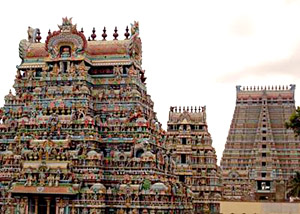 Jatavarman Sundara Pandya I was a great conqueror; he ruled almost the whole of the area extending from Kanyakumari in the south up to Nellore and Cudappah districts in the north. Jatavarman`s conquest of Sri Lanka added a feather to his cap and the king of this island nation was made to pay tribute to him. Many of the smaller chieftains were also subdued and thus his conquest of the whole of the ancient Tamil country and some neighbouring areas was complete. His inscriptions found at various temples across Tamil Nadu, provide evidence to his heroic conquests and his philanthropic nature.
Jatavarman Sundara Pandya I was a great conqueror; he ruled almost the whole of the area extending from Kanyakumari in the south up to Nellore and Cudappah districts in the north. Jatavarman`s conquest of Sri Lanka added a feather to his cap and the king of this island nation was made to pay tribute to him. Many of the smaller chieftains were also subdued and thus his conquest of the whole of the ancient Tamil country and some neighbouring areas was complete. His inscriptions found at various temples across Tamil Nadu, provide evidence to his heroic conquests and his philanthropic nature.
Conquests of Jatavarman Sundara Pandya I
His first invasion was that of the Chera region ruled by Viraravi Udaya Marthandavarman. Their king was killed and army was completely destroyed. Thereafter he attacked the ruler of the Chola dynasty, Rajendra Chola III who was forced to accept his supremacy.
The Hoysala territories including the stretch along River Kaveri and fortress of Koppam were occupied by him. Many Hoysala generals were killed in this battle. This invasion was blocked after Somesvara I took over the kingdom. Later on when Somesvara tried to invade Pandyan kingdom in 1262 AD he was defeated and eventually died. He thereafter defeated the Kadava king Kopperunchingan II and also captured the fortress of Sendamangalam. However, it was all reinstated back to the Kadava king. During his expedition against the Kadavas he also conquered Magadai and Kongu.
Pandyan forces under the prince Jatavarman Pandyan I invaded the island of Sri Lanka. They defeated and killed one Sri Lankan prince and Chandrabhanu accepted the supremacy of the Pandyas. This invasion was during 1262 AD and 1264 AD during the reign of the king Parakkamabahu II.
Sundara Pandyan undertook an expedition to the North of their empire. There they killed the Telugu ruler Vijaya- Gandagopala and captured Kanchipuram in 1258 AD. Here that also entered into a conflict with the Kakatiyas under Ganapati II. The Pandyan army defeated a Telugu army at Mudugur in the current Nellore district. The Kadava Pallava ruler had weak successors and Sundara Pandyan captured Nellore, Kanchi, Visayavadai regions.
Architecture under Jatavarman Sundara Pandya I
Sundara Pandyan devoted much of his time to temples. He used the wealth he procured from the wars to revamp the temple of Lord Shiva in Chidambaram and the temple of Lord Vishnu temple in Srirangam. Many endowments were given to temples in Trichy, Tanjore and Kanchipuram. He had built a temple at Aragalur. He had also built a gate at the Sri Ranganathaswami temple at Srirangam in which he engraved the names of Cholas, Pallavas, Pandyas and the Cheras. East tower of the Meenakshi Temple in Madurai was constructed during his rule.
Sundara Pandyan assumed various titles like "Emmandalamum Kondaruliya Pandiya", "Tribhuvana Chakravarthy", "Ponveintha Perumal", and "Hemachadana Raja". He died in 1271 AD and was succeeded by Maravarman Kulasekara Pandyan in1268 AD. He is remembered as a great philanthropist and a heroic conqueror.



















